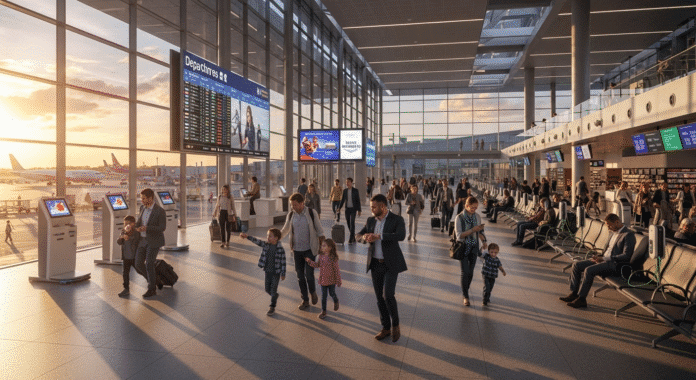New York’s AIR NY Program Delivers Transformative Funding to Enhance Safety, Technology, and Economic Growth
New York’s airports are on the brink of a significant transformation. With $25 million in historic state funding through the AIR NY Aviation Capital Grant Program, 16 airports across New York are set to receive upgrades that boost safety, modernize technology, and improve snow management. These improvements promise not only to ease travel but also to stimulate local economies and enhance community well-being.
Overview of Historic Investments
New York State is taking a bold step in modernizing its transportation infrastructure. The AIR NY program was designed to address longstanding needs in safety, operational efficiency, and environmental resilience at public-use airports. Governor Kathy Hochul announced this funding as a critical measure to ensure that every region in the state benefits from improved airport facilities, technological advancements, and effective winter operations.
The initiative focuses on key goals: securing a safer flying environment, implementing cutting-edge technology, and fighting the challenges posed by harsh winter weather. By investing in areas like new snow removal equipment, deicing systems, and energy-efficient technologies, the program aims to create a ripple effect of economic growth while enhancing the experience of both residents and visitors.
Funding Breakdown and Planned Upgrades
The $25 million allocated by Governor Hochul’s office is distributed among 16 airports, each receiving funds tailored to its unique needs. The upgrades range from expanding deicing systems to building new hangars with renewable energy features. The following sections provide a detailed picture of how these funds will make a tangible difference.
Major Recipients and Their Projects
Syracuse Hancock International Airport, one of the program’s major beneficiaries, will receive $2.5 million to build a new snow control center. This vital facility is designed to improve winter operations and ensure that flights can depart safely even during the coldest months.
Buffalo Niagara International Airport is set to receive another $2.5 million aimed at expanding its deicing fluid collection system. Upgrading this system not only promotes environmental resilience but also strengthens the airport’s ability to manage snow and ice efficiently.
Griffiss International Airport’s $2.33 million investment will fund a new sand and salt storage building. This upgrade is central to enhancing snow removal will improve runway safety and reduce the likelihood of winter-related delays.
Finger Lakes Regional Airport has been earmarked for $1.58 million to construct a maintenance equipment building that will streamline operational procedures. In the same vein, Plattsburgh International Airport will benefit from $752,960, which will be directed toward securing access gate upgrades, thereby enhancing security and passenger flow.
Additional Beneficiaries and Their Upgrades
Other airports across the state are also experiencing significant improvements:
• Adirondack Regional Airport has been allocated funds for new electric ground service equipment, a move that supports both environmental sustainability and operational efficiency.
• Akron Airport/Jesson Field will see a new hangar equipped with solar capabilities through $1.94 million in funding, highlighting a shift toward renewable energy in aviation facilities.
• Greater Binghamton Airport has received $2.49 million for hangar rehabilitation projects, ensuring that infrastructure can meet modern demands and safety standards.
• Ithaca Tompkins International Airport is set to install geothermal heating and cooling systems with a $1.35 million investment, underscoring the state’s commitment to energy-efficient upgrades.
• Smaller regional airports, including LeRoy, Malone Dufort, Ogdensburg, Orange County, Republic, South Albany, and Watertown International, each receive targeted funds to improve utilities, maintenance facilities, and winter operations. These upgrades directly support smoother day-to-day operations and contribute to the reliability of air travel.
Economic and Community Impact
The improvements being made to these airports extend beyond the runways and terminals. They are a catalyst for economic development and community revitalization across New York. With modernized facilities, airports can handle increased passenger volumes and attract more business investments, which in turn create jobs and promote local tourism.
Governor Hochul emphasized the broader benefits when she said, “Thanks to our historic investments, New York’s airports are soaring to new heights and invigorating their local communities with new opportunities for economic growth and tourism.” Enhanced airport operations also contribute to more dependable travel during inclement weather, ensuring that critical economic links remain strong between New York and the rest of the nation.
In areas where smaller regional airports are receiving upgrades, local businesses and community leaders can look forward to new opportunities. Improved infrastructure often leads to better connectivity, which is essential for exporting local products, attracting visitors, and hosting events that boost local pride and economic output.
Enhancing Safety and Operational Efficiency
Safety remains at the core of the AIR NY program. With new snow removal equipment and deicing systems, the upgraded infrastructure is expected to significantly reduce weather-related delays and accidents. By modernizing operations through state-of-the-art technology, airport staff can monitor runway conditions more efficiently and respond faster during emergencies.
The investment in renewable technologies, such as geothermal systems and solar-powered hangars, also represents a significant step forward in reducing the environmental footprint of these facilities. This move not only contributes to greener operations but also sets a precedent for how public infrastructure can align with broader environmental goals.
Operational efficiency is another key aspect. Upgrades in maintenance facilities, utility connections, and security systems ensure that airports will run smoother. This improved efficiency benefits travelers in real time, as delays are minimized and overall travel experiences become more predictable.
Voices from the State
Official statements from state leadership underscore the importance of these investments. Governor Hochul celebrated the funding announcement, noting that the funds will help New York airports not only manage winter weather better but also provide modern amenities that boost local economic competitiveness. In a similar vein, New York State Transportation Commissioner Marie Therese Dominguez commented on the initiative, saying, “These AIR NY investments will help ensure that our local communities are able to make important improvements in the safety, security, and resilience of their airports.” Such endorsements reflect a shared commitment among state leaders to ensure that New York remains at the forefront of safe and sustainable air travel.
Critics have raised concerns about whether the allocated funds can address all infrastructural challenges at these airports. However, state officials have been quick to reassure the public that the AIR NY program is part of a broader, ongoing effort to modernize the state’s transportation network. By continually assessing airport needs and investing in critical upgrades, New York aims to maintain and improve its status as a key transportation hub.
Looking Ahead: What This Means for Travelers and Communities
These funding upgrades are already generating enthusiasm among local residents and frequent travelers. The implementation of improved safety measures, such as new deicing systems and snow control centers, means that airports are better equipped to handle harsh winter weather. For travelers, this translates into fewer delays and enhanced overall safety.
For community members, the upgrades bring hope for economic revitalization. New jobs are expected to be created during the upgrade construction phase and beyond, while enhanced facilities can attract more passengers and business travelers alike. In turn, local businesses may see an uptick in commerce, and communities will have access to more reliable transportation networks.
Local leaders recommend that residents stay engaged by following updates from their regional airports and participating in community forums. This involvement ensures that feedback on these upgrades is shared and considered in future developments.
New York’s Airports Set for a Safer, Greener Future
The $25 million investment provided by Governor Hochul’s AIR NY program marks a turning point for New York’s aviation infrastructure. With targeted upgrades ranging from improved snow removal systems to state-of-the-art renewable energy solutions, the state is laying the groundwork for safer travel and stronger economic growth. These improvements not only enhance safety and efficiency but also serve as a model for sustainable infrastructure investments across the nation.
As New Yorkers experience these changes firsthand, it is clear that the benefits extend far beyond the airport runways. The upgrades are poised to create jobs, support local businesses, and enhance overall quality of life through improved connectivity and sustainability. What do you think about these transformative changes? Join the conversation and share your views on the future of New York’s airports.




